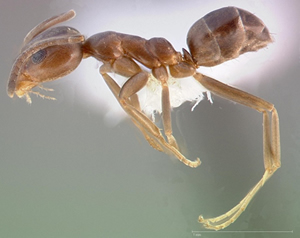
Identification
Key features
The following features distinguish Argentine ants from other species present in New Zealand.
Basic
- Small size (2–3 mm)
- Light brown in colour (not black, orange/red, yellow)
- Workers all same size
Technical characters (a high-powered microscope of 20–40x magnification is needed)
- Petiole only one segment (between mesosoma and gaster)
- Sting absent
- Antennae 12-segmented and without club
- Eyes placed low on head with the widest point of head above eyes (to distinguish from Iridomyrmex)
- Weakly concave front margin of clypeus
- 5–8 large teeth on the mandibles
- Mandibles longer than wide (to distinguish from Doleromyrma darwiniana; Darwin's ant)
- Upper and rear faces of the propodeum equal in length (to distinguish from Doleromyrma darwiniana; Darwin's ant).
Tools
|
|
Field identification
There is no absolute feature that can solely identify Argentine ants in the field. The below features are helpful, but some other ant species also possess these.
- Workers are about 2–3 mm long and a uniform light-brown colour (compared with the common black species found foraging in urban areas in New Zealand).
- The ants move quite fast (not ponderous).
- They walk in defined continuous trails (not erratic ‘crazy’ behaviour of running about in circles)
- They have only a slight greasy odour when crushed, as opposed to the strong formic acid smell of some ant species.


